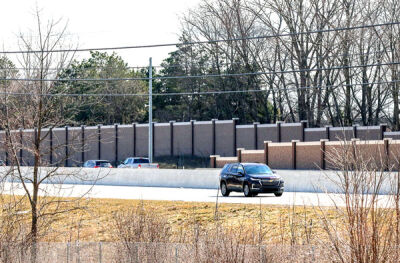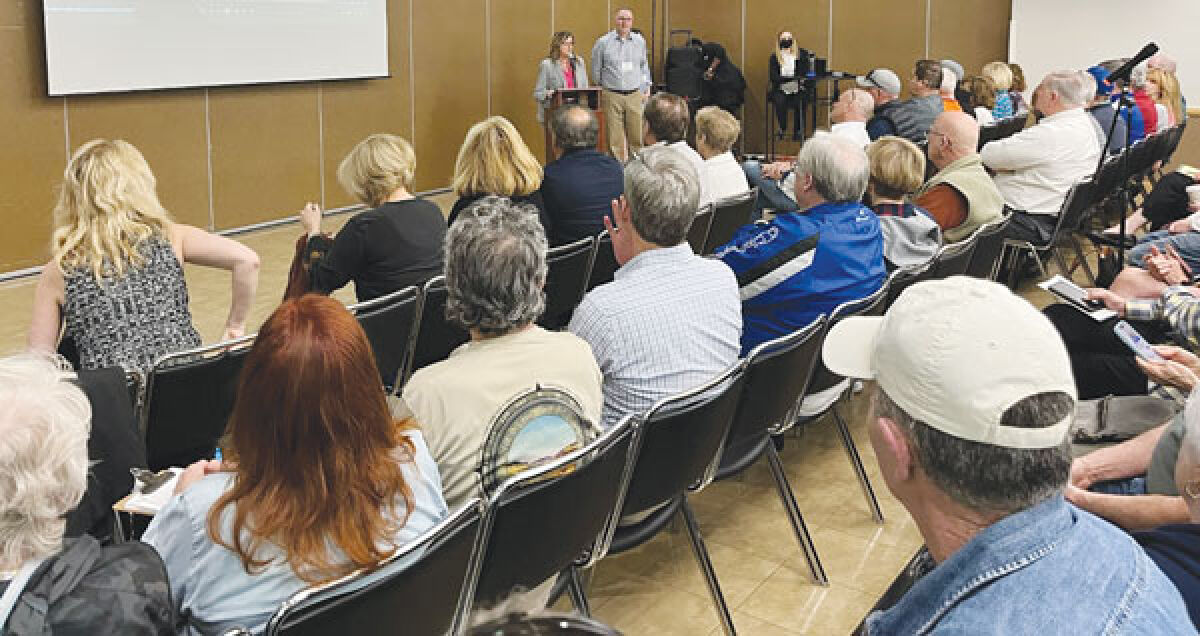
Two sections of I-75, between Wattles Road and Crooks Road, were approved for sound mitigation by MDOT, but there is not enough funding appropriated for the projects to begin.
File photo by Patricia O’Blenes
TROY — The Michigan Department of Transportation hosted a public hearing at the Troy Community Center April 11 to discuss the results of a sound study it conducted along portions of Interstate 75 in Troy.
The sound study came after numerous residents in the Troy community petitioned their state representatives to appropriate funding for such a sound study due to the high level of noise coming from I-75, particularly after work on the freeway was completed in 2020.
“They changed the freeway, so they raised it up, so the sound travels farther,” said Loraine Scussel, one of the affected residents who started the petition. “They added lanes, so traffic is closer to residents. They demolished vegetation, which previously served to knock down or muffle some sound. Some people live on the opposite side of the freeway from a wall, so the sound bounces back to us. They made these changes without any consideration of how it would affect people living nearby. We didn’t ask for this or approve this. Now we’re the ones who are affected.”
MDOT performed the study earlier this year and concluded that two areas do meet the criteria for having sound mitigation measures, such as sound dampening walls installed to help alleviate the level of noise affecting nearby residents.
“We studied several of the residential areas along the freeway. We got through a certain portion of the study and identified two neighborhoods that met our criteria for action,” Rob Morosi, a spokesperson for MDOT, explained. “They would be eligible for noise abatement measures. However, we don’t have the funding available for that right now to put walls in.”
The two areas include portions of I-75 between Wattles Road and Crooks Road.
“Both areas that qualified for noise abatement measures are along I-75,” said Morosi. “Right now we have a wall along the northbound side that starts around Wattles Road and continues north, and then there is a gap between Hedgewood to Long Lake, and that gap qualifies for noise abatement. The other area that qualified is between Coolidge Highway and Crooks Road, also on the northbound side.”
He said that these two areas meet the criteria now, but did not when the work on I-75 was completed.
“When we did the original sound study, the rate of inflation has lifted the cap of the maximum value per resident threshold that determines whether a sound wall or other measure in these two areas is considered reasonable in terms of cost and feasibility,” said Morosi. “Back in 2017, the truck speed limit was raised, so they are traveling faster now and thus creating more noise.”
However, without designated funding from the Michigan Legislature, MDOT has no budget to begin the two projects, they said; $4 million was set aside by the Legislature when the sound study was approved, but this would cover less than half of the $8.25 million to $12.25 million price tag MDOT estimates the sound walls for the two approved sections would cost. MDOT said it is up to residents to continue petitioning their state representatives to allocate the money for such a project.
“We’re not surprised about the funding,” said Gail Morrell, one of the affected residents involved in pushing for the sound study. “We anticipated this to an extent. We have already set a course to try and find out how we might get some funding for these projects with state government officials.”
“They said that out of all the areas they measured, two have met the level for feasibility and reasonable criteria — even using their flawed system,” Scussel added. “But these two new walls don’t have funding. They are saying they are finished with this project and for Troy residents to move forward we need to figure out how to obtain the funding from our elected officials. … We are now contacting our representatives to discuss funding and MDOT’s methodology in their study. … There’s a $9 billion budget surplus in Lansing, so we want to know why this money can’t be found.”
Furthermore, many residents expressed their belief at the meeting that the standards by which MDOT performed their sound study were flawed and that several other areas along I-75 should also qualify for sound mitigation efforts.
“We believe that the entire process for conducting the sound study is completely flawed,” said Scussel. “We have scientists on our citizens team who did their own sound study. Another subdivision paid for their own as well. Both results disagree with MDOT’s results. What MDOT did was according to their laws and regulations, but they were only taking 15-minute sound measurements at the quietest times of the day, and they took that data and put it into an old computer modeling system which doesn’t take new factors like new sound walls or new types of cement into account.”
“They did cite two areas where they could put measures in place to mitigate the sound, probably in terms of a wall,” Morrell added. “They are the areas we were most concerned about, so we were pleased that some action has at least been called for. One is near Livernois and Wattles, and the other is near Firefighters Park. Everyone at the meeting had a legitimate complaint, though.”
Scussel added that the World Health Organization uses a far lower standard for an acceptable level of background noise to be healthy for people to be exposed to over long periods of time.
“(MDOT) used 66 decibels as their basis,” she said. “This is not an acceptable target for human beings in terms of background sound. The WHO lists the acceptable level at 53 decibels. If MDOT would have used 53 decibels as their ceiling, every resident who has complained would qualify.”
Scussel thinks that MDOT officials have their hands tied by the regulations in place, so there is little they can do at this point, even if they did want to take action. However, she does think there are options the state can look at to help mitigate the situation.
“The scientists who did their own studies say that cement blocks are not necessarily the best option. There are other noise mitigation materials that would absorb the sound better. We’ve looked at what other places use that might absorb the sound better than the walls they are using right now. Putting a level of asphalt over the top also could help absorb the sound. They can put Plexiglas on the sides of the overpasses … try some other things. We’re willing to serve as a test case. We want them to try and do something.”
Morrell said there is likely still a long road ahead for residents to get the relief they so desperately need. However, she doesn’t want anyone to give up and is encouraging Troy residents to keep pushing for the state of Michigan to find the money and keep looking at the effects the noise from I-75 is having on Troy residents.
“I just don’t want people to give up. If we didn’t get a petition together, no sound study would have happened at all,” she said. “We’ve been working for three years just to get to this point. Even if there was funding, new walls wouldn’t go up immediately. It’s a process, and we need to keep going one way or another.”
 Publication select ▼
Publication select ▼




















